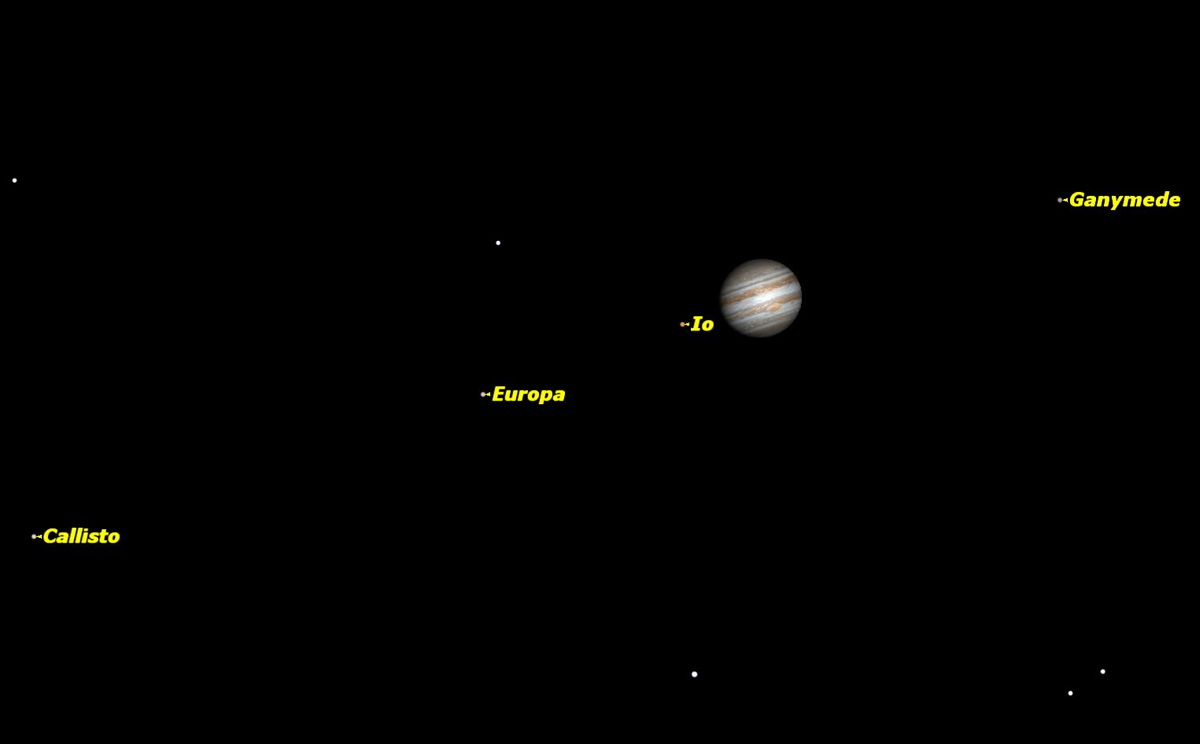
On Saturday and Sunday, you can finish the day by stepping outside and enjoying a view of the rendezvous of two of the brightest objects in the night sky — the moon and the planet Jupiter.
About 45 minutes after the sun sets on both nights, the eye-catching celestial duo will be visible in the southwest sky, roughly two-thirds of the way up from the horizon to the point directly overhead (called the zenith).
The moon will officially reach first-quarter phase on Saturday evening (April 25) at 7:55 p.m. EDT (2355 GMT). The terminator — the line separating the light half of the moon (on the right) from the dark half — will appear perfectly straight, and Jupiter will be about 9 degrees above and to the left of the moon's left. (Reminder: Your clenched fist held at arm's length measures about 10 degrees.)
On Sunday evening (April 26), the two celestial bodies will be just 8 degrees apart. But on that day, the moon will be in a waxing gibbous phase and will be situated to the lower left of Jupiter.
Even without the moon, Jupiter readily attracts attention: At about magnitude minus 2.1, the gas giant outshines everything in the night sky except Venus and the moon. These days, Jupiter first comes into view high in the southwest during the early stages of twilight and sets at around 2:45 a.m. local daylight time.
In a telescope, Jupiter is a prime attraction, best observed during early evening when it's still high and its image reasonably calm. The giant planet appears as a great, big, belted ball showing tantalizing glimpses of detail. Admittedly, Jupiter currently appears only 75 percent as big as it did at opposition in early February, but don't let that stop you from searching for the planet. The quirks of atmospheric conditions, which can change from minute to minute, often make a bigger difference in what a telescope will show of Jupiter than does the planet's apparent size. And Jupiter's four bright Galilean moons (Ganymede, Callisto, Io and Europa) are always performing.
Finally, take note of this: Jupiter is now just two months away from a spectacularly close conjunction with Venus, which will occur on July 1.
Get the Space.com Newsletter
Breaking space news, the latest updates on rocket launches, skywatching events and more!
Joe Rao serves as an instructor and guest lecturer at New York's Hayden Planetarium. He writes about astronomy for Natural History magazine, the Farmer's Almanac and other publications, and he is also an on-camera meteorologist for News 12 Westchester, N.Y. Follow us @Spacedotcom, Facebook or Google+. Originally published on Space.com.
Join our Space Forums to keep talking space on the latest missions, night sky and more! And if you have a news tip, correction or comment, let us know at: community@space.com.

Joe Rao is Space.com's skywatching columnist, as well as a veteran meteorologist and eclipse chaser who also serves as an instructor and guest lecturer at New York's Hayden Planetarium. He writes about astronomy for Natural History magazine, Sky & Telescope and other publications. Joe is an 8-time Emmy-nominated meteorologist who served the Putnam Valley region of New York for over 21 years. You can find him on Twitter and YouTube tracking lunar and solar eclipses, meteor showers and more. To find out Joe's latest project, visit him on Twitter.









